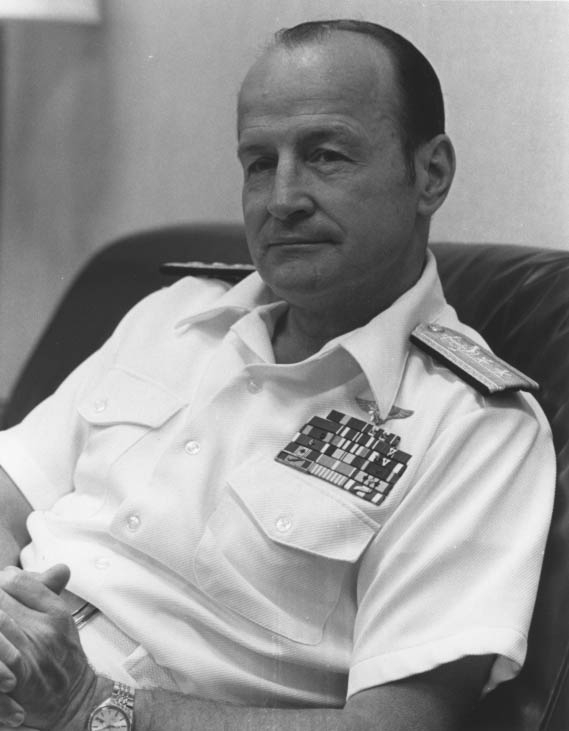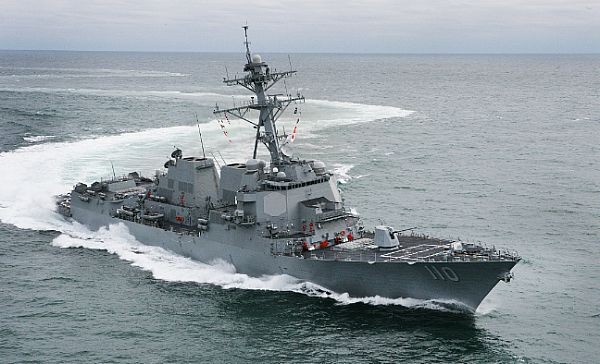
William Porter Lawrence, born in Nashville, Tenn., on 13 January 1930, to Robert L. Lawrence, Jr., and Tennie [Brewer] Lawrence, entered the U.S. Naval Academy with an appointment from his native state in 1947. Graduating with distinction with the USNA Class of 1951, he received his commission as ensign on 1 June 1951. Designated a naval aviator upon conclusion of flight instruction at Naval Air Station (NAS) Pensacola, Fla., on 7 November 1952, he continued training until February 1953, after which he joined Fighter Squadron (VF) 193, based at NAS Moffett Field, Calif., as an all-weather fighter pilot. While serving in that squadron, he made two Western Pacific deployments in the attack carrier Oriskany (CVA-34).
After attending the Aviation Safety Course at the University of Southern California at Los Angeles (October-December 1955), Lawrence received test pilot training at the Naval Air Test Center, Patuxent River, Md., graduating first in his class. He remained there as a test pilot following the completion of that instruction in August 1956. During his time at "Pax River," Lawrence became the first naval aviator to fly at twice the speed of sound, in a Vought F8UCrusader, in 1958. The following year, he applied for the initial astronaut program and finished among the 32 candidates for Project Mercury, but a minor physical defect disqualified him.
Reporting for duty as flag lieutenant to Rear Adm. Thomas H. Moorer, Commander, Carrier Division (CarDiv) 6, in June 1959, who wore his flag in the carrierSaratoga (CVA-60) in the Mediterranean and the North Atlantic, Lawrence later joined VF-101, Detachment "A," as assistant operations officer, at NAS Oceana, Va., where he helped introduce the new McDonnell F4H Phantom to the fleet. Following a tour as navigator on board the heavy cruiser Newport News (CA-148) (June 1961-June 1962), he then served as maintenance officer in VF-14, based at NAS Cecil Field, Fla., deploying to the Mediterranean on board the carrierFranklin D. Roosevelt (CVA-42).
Subsequently serving as the senior aide and executive assistant to Gen. Paul D. Adams, USA, the Commander in Chief, U.S. Strike Command/Commander in Chief, Middle East, Africa South of the Sahara and South Asia, headquartered at MacDill Air Force Base, Fla., (1 February 1964-20 January 1966), Lawrence later received a Joint Service Commendation Medal that honored his "utmost professional competence and devotion to duty [in carrying out] his many diverse responsibilities."
Receiving prospective executive officer training with VF-121 (February-July 1966), Lawrence then joined VF-143 as exec. He relieved Comdr. Marland W. Townsend as commanding officer of VF-143 on 15 June 1967, at NAS Cubi Point, Philippine, after one line period on board the carrier Constellation (CVA-64). A little over a week later, on 23 June, Lawrence led a strike against the "heavily defended rail yard and thermal power plant" at Nam Dinh, North Vietnam, spearheading the flak-suppression efforts that personally accounted for a multiple-gun emplacement. For his "airmanship, resourcefulness and courageous dedication," he later received a Distinguished Flying Cross.
On 28 June 1967, less than a fortnight after he had assumed command of VF-143, Lawrence returned to Nam Dinh, leading a Rolling Thunder flak suppression mission against the sites protecting the vital POL (petroleum, oil, and lubricants) Storage and Transshipment Areas there. Antiaircraft fire hit Lawrence's McDonnell F4B (BuNo 152242) (voice call Taproom 301) after he had delivered his ordnance, and his wingman saw the Phantom's tail surfaces shedding pieces. Lawrence reported loss of control, and voiced his intent to try and reach the Gulf of Tonkin. Damage to the plane, however, prevented him from doing so, and both he and Lt. (j.g.) James W. Bailey, USNR, his radar intercept officer (RIO), ejected from the crippled F4B at 4,000 feet. Lawrence's wingman saw two parachutes deploy, but heavy cloud cover prevented him from seeing the pilot and RIO land. During his descent, Lawrence radioed that both men were "okay," but they soon landed in a heavily populated area, deep in the enemy's heartland, and the North Vietnamese captured them soon thereafter.
For almost six years, Lawrence, who would receive a Silver Star for the courage and determination displayed during the mission of 28 June 1967, remained a prisoner of war (POW). As senior ranking officer of "Camp Vegas" POW camp, and of other cellblocks during that period, he displayed conspicuous diligence, perseverance, loyalty to his country, and devotion to duty during times of duress, resisting North Vietnamese attempts "to use him in causes detrimental to the United States." Leading by example, Lawrence "provided...guidance to is fellow [POWs]," in formulating "firm and explicit guidelines" and "setting a pattern of resistance" for all to follow. His "extraordinary courage, resourcefulness, and sound judgment" earned him the Distinguished Service Medal.
A fellow POW declared that Lawrence's performance of duty "among a group of heroic figures…was the most heroic of all." Vice Adm. James B. Stockdale, the ranking U.S. Navy POW, called Lawrence's achievements in Hanoi "a chronicle of patriotic loyalty, personal bravery, physical toughness, compassionate aid to his fellows, and inspirational leadership." Recalled the words attributed to a naval hero of America's War for Independence, Stockdale asserted that Lawrence would not bow to intimidation "and never gave up the ship."
Repatriated in March 1973, Lawrence received hospitalization at the U.S. Naval Hospital, Millington, Tenn., after which he reported, in August 1973, to the National War College, Washington, D.C., for instruction. During that period, he pursued a course of study at George Washington University, Washington, D.C., receiving a Master's Degree in International Affairs in July 1974.
Promoted to flag rank in July 1974, Lawrence became Commander, Light Attack Wing, Pacific, headquartered at NAS Lemoore, Calif., then served as Director, Aviation Programs Division and Assistant Deputy Chief of Naval Operations (Air Warfare), in the Pentagon, OP-05B. On 28 August 1978, he became Superintendent of the U.S. Naval Academy, and received promotion to vice admiral on 1 August 1980. In September 1981, he became Commander, Third Fleet.
Two years later, Vice Admiral Lawrence became Deputy Chief of Naval Operations (Manpower, Personnel, and Training) (OP-01)/Chief of Naval Personnel, with the responsibility of formulating and seeing to the implementation of policies relating to the Navy's people. Dubbed the "Sailor's Admiral," Lawrence championed the causes of the service's men and women, reflecting a deep concern for their welfare in improving "compensation, quality of life, educational programs, promotion opportunity, and career attractiveness..."
Lawrence retired from active naval service on 1 February 1986, and soon thereafter occupied the Chair of Naval Leadership at the U.S. Naval Academy. Lawrence died on 2 December 2005.
(DDG-110: displacement 8,300 (full load); length 504'6"; beam 66'11"; draft 30'7"; speed 30+ knots; complement 341; armament 1 5-inch, 2 Phalanx, 2 vis.,Tomahawk, Standard missile., ASROC, 6 21-inch torpedo tubes; class Arleigh Burke)
William P. Lawrence (DDG-110) was laid down on 16 September 2008 at Pascagoula, Ms., by Huntington Ingalls Industries; launched on 15 December 2009; co-sponsored by Mrs. William P. [Diane] Lawrence, widow of the late Vice Adm. Lawrence, and the admiral's two daughters, Dr. Laurie M. Lawrence and Capt. Wendy B. Lawrence, USN (Ret.); delivered to the Navy on 23 February 2011; and commissioned at Mobile, Ala., on 4 June 2011, Comdr. Thomas R. Williams, II, in command.



